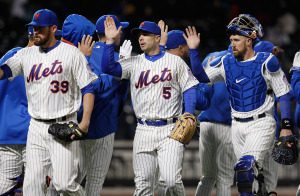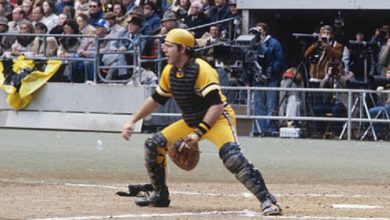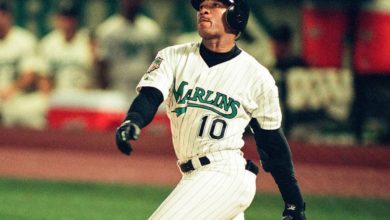

With the All-Star break in a few days, the New York Mets have shown signs of improvement. They’re 7-3 in their last 10 games, they’ve got one of the best road records in the National League, their bullpen has improved noticeably, and they seem to be playing with more energy and confidence. They’re still on the outskirts of the wild card race, and whether they climb further into contention depends on continued improvement in the areas below.
Starting pitching
The New York Mets’ starting pitching has been strong in the second quarter, with Jeremy Hefner (yes, you read that correctly) leading the charge. He’s only given up eight earned runs in his last six starts, in which the Mets are 5-1. His curveball has been devastating, his location has been sharp, and he’s pitched well in close games and under situational pressure. As we know, Hefner’s not even the team’s ace; that distinction goes to Matt Harvey, who continues to pitch like a Cy Young candidate. Harvey’s 7-2, and there are another half-dozen games he would have won with even a little but of run support. His ERA is 2.35, and his WHIP is 0.92, which is ridiculous for a rookie starter halfway through the season. Zack Wheeler is coming off his strongest performance thus far, holding the San Francisco Giants to one run in seven innings to complete the New York Mets’ first West Coast road sweep in decades. Solid top-rotation starter Jonathon Niese is on the 15-day disabled list, but his ailing shoulder had a favorable MRI, and he’s working on returning soon. Rounding out the staff, Dillon Gee has shown signs of rebounding of late and is capable of delivering solid outings. Grade: A-
Relief pitching
The New York Mets have played a handful of astoundingly long games in the past few weeks, and you can’t do that without relief pitching (with the exception of a recent game where they gave up the lead three times in extra innings). The bullpen has pitched well in recent weeks, getting situational outs and occasionally delivering lengthy individual appearances to keep games close. Terry Collins has pushed the right buttons with his relief crew of late, and it’s fueled the team’s recent surge. At closer, Bobby Parnell remains one of the team’s brightest spots. Despite a recent hiccup, Parnell’s season ERA is 2.41 and his WHIP is a stingy 0.90. Grade: B+
Defense
The New York Mets’ defense is another area that’s seen improvement in the second quarter. Omar Quintanilla has been a pleasant surprise at shortstop, as he’s added spectacular plays to his anticipated steadiness. David Wright continues to have one of his best defensive seasons at third, and Daniel Murphy has become a dependable, if not show-stopping, second baseman. At first base, Josh Satin has played solidly average defense, and Ike Davis adds slightly more range but hasn’t been as outstanding as in his rookie season. In the outfield, Marlon Byrd has been solid in right, getting good jumps and covering decent ground. He’s also shown a strong, accurate throwing arm, leading the team with six outfield assists. Juan Lagares has played an excellent center field, combining good reads with outstanding speed and fluidity, and Kirk Nieuwenhuis has played the position with speed, hustle and athleticism. In left field, newcomer Eric Young, Jr. has shown speed and good instincts, rounding out a defensive outfield that is suddenly one of the National League’s best. Behind the plate, John Buck has been sure-handed and solid, guiding the Mets’ young staff through games effectively. Anthony Recker has been decidedly average, though he’s shown flashes of his old football days while blocking the plate. Grade: B+
Hitting
Despite occasional outbursts, the New York Mets’ offense still seems to be their weak link. They often struggle to hit with runners in scoring position, they strike out far too much, and their younger players like Nieuwenhuis and Lagares often seem too easily fooled. Jordany Valdespin has more or less disappeared, and John Buck has fallen off precipitously since his outrageously hot start. Davis, despite a briefly encouraging stretch and an improved eye for the strike zone, seems to be reverting to some of his old ways. He pulls his front side out jerkily, so that when he gets a pitch he should be able to drive, he floats it to the outfield, rolls it weakly to the infield or fouls it off. He rarely hits the ball with true authority, and his cold zones seem to take up half the strike zone. Satin has been a pleasant surprise: a patient, line-drive hitter with occasional power, who consistently makes contact and can extend at-bats by fouling off tough pitches. Unfortunately, with Ike’s return, he isn’t seeing the field as regularly any more.
Wright’s offensive year is as good as his defensive year. He’s driving in runs, hitting for average and hitting for power without compromising his gap-to-gap strength. Prior to Ike’s return, Wright benefited from a bit of lineup protection, as the resurgent Byrd has performed beyond the expectations of even those, like me, who expected him to be a positive addition. Recker has hit a couple of important clutch home runs, but also has had troubling at-bats, consistently chasing un-hittable pitches and watching third strikes cross the heart of the zone. Daniel Murphy has been slumping and showing signs of frustration. His batting average has fallen to .271, and lately he’s getting under the ball too often. Hopefully, the All-Star break will give him a chance to reset and bounce back, as his impact has definitely been missed.
One positive addition has been Young at the top of the order. Acquired from the Colorado Rockies, Young is a speedy switch-hitter who’s reached base consistently and has begun to steal bases more aggressively. His presence gives the New York Mets the leadoff spark they’ve been in search of since Jose Reyes. At age 28, Young could be the leadoff hitter of the future.
With the addition of Young’s spark and Byrd’s contagious hustle, the New York Mets have become a more dynamic threat. Nieuwenhuis seems slightly improved at hitting the breaking ball, Buck seems to be cutting down his swing and attacking the gaps, and Quintanilla has shown an interesting knack for situational line drives. Murphy’s slump is bound to end soon. If Lucas Duda can return from the DL, Satin gets more playing time and Young continues to set the tone from the top, the Mets’ offense can score enough runs to give their improved pitching staff a little breathing room. Grade: B-
Coaching
Tim Teufel‘s aggressive advisement on the bases has helped fuel recent outbreaks of offense. The New York Mets seem to be playing with improved energy and confidence, and Collins seems to pushing the right buttons with his bullpen. However, Collins’ in-game moves are occasionally baffling. He seems to oscillate between excessive tinkering and an over-reliance on a “by the book” approach, and he doesn’t always seem to know whether or not his starters are cooked. To his credit, though, he obviously cares about his team, and on his watch, they seem to be playing with a new sense of life. Grade: B
Overall
The New York Mets have pitched well, played good defense, and hit just well enough to win the majority of their games of late. They’re still on the outskirts of the playoff race, but the rest of the National League East is busy proving themselves beatable and the division still seems fairly wide open. The Mets will have to get over their problems winning on their home field, which is the opposite problem most teams face regarding the home/away split. If Duda gets healthy and returns to form, the power infusion in the middle of an increasingly promising lineup will help them score enough runs to have a strong second half.
With a strong pitching rotation, an emerging closer and a solid defense, the New York Mets would be a headache to most teams in a short series or single-game playoff. They just have to get there. Ya gotta believe. Grade: B+





